|
There are two main courses of study at Zong Wu Men Internal Fighting Arts - Baguazhang and Xingyiquan.
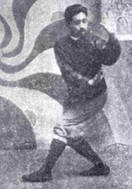 Baguazhang, or "eight trigram palm," is an internal style of Chinese martial art emphasizing the development of the whole body and mind in training. It is most recognizable for its core practice of walking in a circle and emphasizes all manner of striking, control, locking and throwing with all parts of the body. Baguazhang takes ancient Taoist theory and thought and puts it into physical practice in the human body. Baguazhang, or "eight trigram palm," is an internal style of Chinese martial art emphasizing the development of the whole body and mind in training. It is most recognizable for its core practice of walking in a circle and emphasizes all manner of striking, control, locking and throwing with all parts of the body. Baguazhang takes ancient Taoist theory and thought and puts it into physical practice in the human body.
At Zong Wu Men, we specialize in the study of the YiZong Branch of Gao style Baguazhang, which today has become famous among martial artists the world over not only for its excellent health and mental benefits, but also for its proven track record in producing excellent fighters and martial artists.
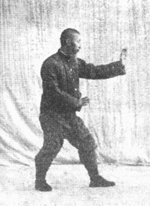 Xingyiquan literally means form and mind fist. As such, its training emphasizes the combining of form, body and movement together with the tempered use of mind and intent. Xingyiquan is probably the most direct, the most outwardly martial, and potentially the most quickly learned of the three internal martial arts of China. Xingyiquan literally means form and mind fist. As such, its training emphasizes the combining of form, body and movement together with the tempered use of mind and intent. Xingyiquan is probably the most direct, the most outwardly martial, and potentially the most quickly learned of the three internal martial arts of China.
Xingyiquan stresses control of centerline, direct hard-hitting attacks and exacting simplicity. The core training of Xingyiquan consists of standing meditation methods and the training of the five element fists to forge one's understanding of the base structure, techniques, principles and strategy of the system. Much of the basic fighting attitude of Xingyiquan revolves around aggressive occupation of the opponent's territory. Later, one will move on to the training of more advanced forms in the system, as well as two person forms, weapons and advanced fighting and training methods.
Zong Wu Men - Body, Mind, Movement... Control.
Training at Zong Wu Men might be a little different than training in other martial arts or health-oriented classes (i.e. yoga, qigong, taiji for health, etc.). The head instructor believes in the spirit of the traditional approach to training these arts. It is their tradition to be inclusive and holistic, therefore, we believe that it is in their very essence to continue these living traditions by drawing in from sources of modern knowledge and ways of communicating their principles. It is also in this spirit that we train them with full attention paid to their traditional martial aspects, keeping our fighting and life skills applicable to the modern world which we face today.
We approach every facet of our training with the concern of every other facet of one's training right there with it. One visiting student from another martial art once astoundingly described our approach to fight training as a "comprehensive, cohesive approach to combat." It is probably more appropriate to say that we view it as a comprehensive approach to understanding one's body, mind, movement and control thereof. Although this is a tradition of martial arts, and we do not shy from serious conditioning and fight training, it is also in this tradition to understand one's body, mind and movement on deeper levels. Developing control of one's self, one's body, one's mind is a profound and involving process.
Some of our concrete goals in training are as follows:
- Balance and make free one's body, mind and movement. We seek to open the body's joints, muscles, tendons and structure to the extent that we can maximize our capacity for physical strength and freedom of movement through the full range of motion inherent in the human body, while simultaneously trying to connect this process with mindful attentiveness.
- Learn to better control one's body, mind and situation at any given moment in time. Although we approach this larger goal initially from a combat and movement perspective, the lessons learned from taking an honest look at one's self can and should apply to one's life on a larger scale - whether from training, to fighting, to health, to one's interaction with others in a potentially very physically confrontational setting, to the depths of discipline one can take their mind and body.
- To bring focus and awareness to one's mind-intent, also known as yi in Chinese. This intense development of one's yi is the basis of deeper training in the systems we practice, as well as the door to the more meditative aspects of the traditions.
- Understanding the methods and theories underlying these arts on a practical, physical level. Many in the West take a very logical, intellectual approach to training and understanding the Chinese Internal Martial Arts. While this method can occasionally bring a strong light to the why's and how's of our training, this is at odds with not only the traditional methods of passing on the systems, but with their very basis as cohesive, applicable arts. To paraphrase a saying: "boxing is in one's hands, not in the mouth." In the end, it doesn't matter how much you intellectually understand it, it matters how well you do it.
For more information on classes, or to schedule a free trial class, contact George Wood now.
|

. 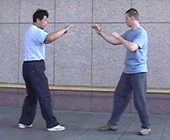
George Wood Laoshi squaring off with his teacher Luo Dexiu
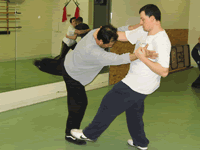
Two students practicing Baguazhang throwing methods
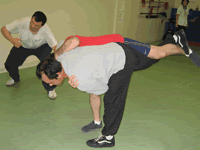
More fun in class
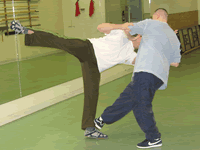
George Wood demonstrating a Bagua throwing technique on a student in class
|

 Baguazhang, or "eight trigram palm," is an internal style of Chinese martial art emphasizing the development of the whole body and mind in training. It is most recognizable for its core practice of walking in a circle and emphasizes all manner of striking, control, locking and throwing with all parts of the body. Baguazhang takes ancient Taoist theory and thought and puts it into physical practice in the human body.
Baguazhang, or "eight trigram palm," is an internal style of Chinese martial art emphasizing the development of the whole body and mind in training. It is most recognizable for its core practice of walking in a circle and emphasizes all manner of striking, control, locking and throwing with all parts of the body. Baguazhang takes ancient Taoist theory and thought and puts it into physical practice in the human body.  Xingyiquan literally means form and mind fist. As such, its training emphasizes the combining of form, body and movement together with the tempered use of mind and intent. Xingyiquan is probably the most direct, the most outwardly martial, and potentially the most quickly learned of the three internal martial arts of China.
Xingyiquan literally means form and mind fist. As such, its training emphasizes the combining of form, body and movement together with the tempered use of mind and intent. Xingyiquan is probably the most direct, the most outwardly martial, and potentially the most quickly learned of the three internal martial arts of China. 



